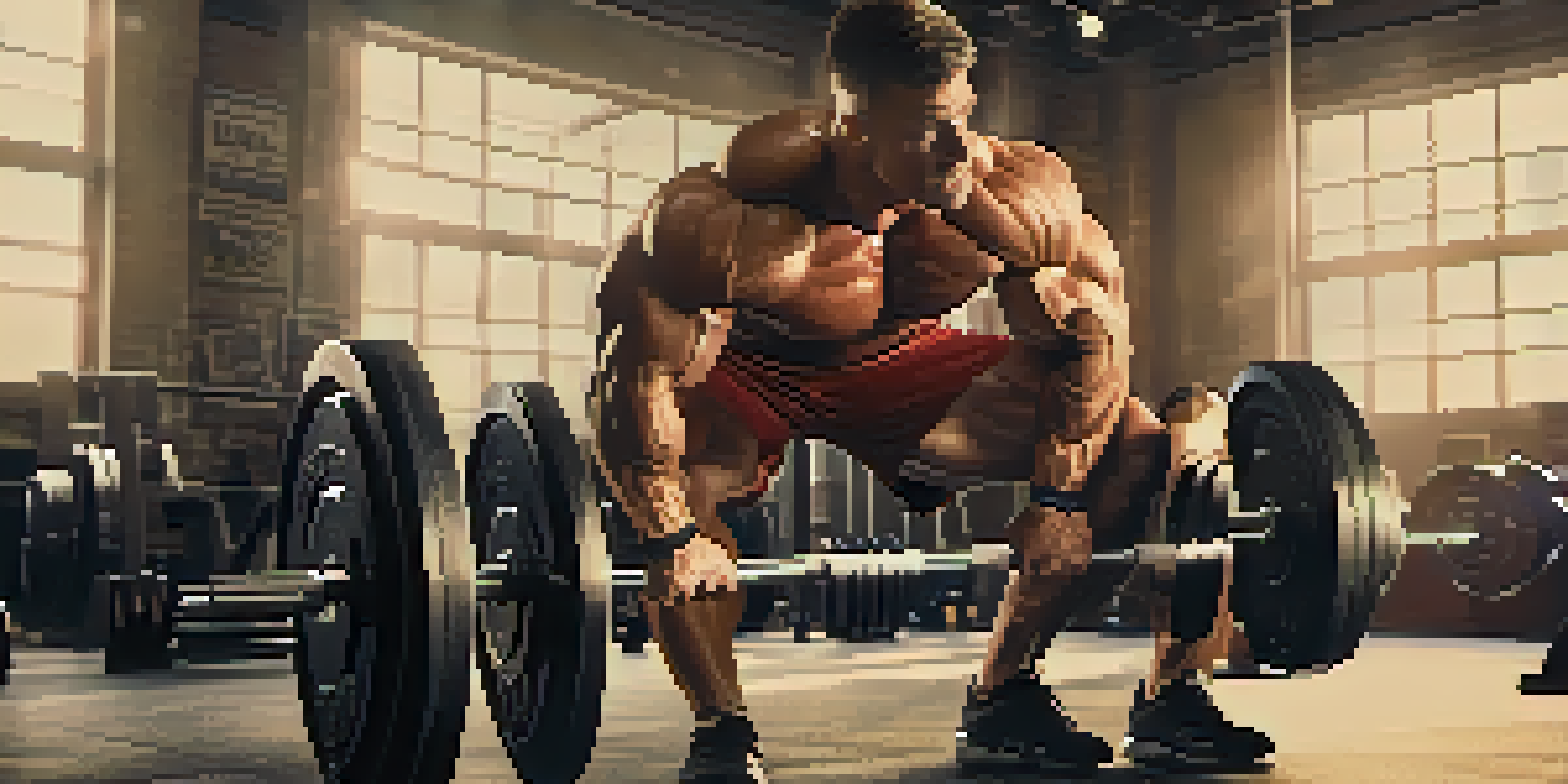Understanding Common Bodybuilding Injuries and Their Causes

Introduction to Bodybuilding Injuries and Their Impact
Bodybuilding is an amazing way to build strength and improve your physique, but it does come with its share of risks. Many enthusiasts push their limits, which can lead to injuries that may sideline them for weeks or even months. Understanding the common injuries associated with bodybuilding can help you stay in the game and avoid setbacks.
The difference between a successful person and others is not a lack of strength, not a lack of knowledge, but rather a lack in will.
Injuries can range from minor strains to major tears, and each type affects a different part of the body. For example, shoulder injuries can stem from improper lifting techniques or overexertion. By being aware of these risks, you can take proactive measures to protect yourself.
Moreover, injuries not only impede progress but can also lead to frustration and discourage individuals from maintaining their fitness routine. This is why knowledge about these injuries is essential for both beginners and seasoned bodybuilders alike.
Common Muscle Strains: Causes and Prevention
Muscle strains are among the most frequent injuries bodybuilders face, often occurring in the back, hamstrings, or shoulders. These strains happen when muscles are overstretched or torn, typically due to poor form or lifting too much weight too quickly. It's crucial to pay attention to your body and recognize the signs of strain early.

To prevent muscle strains, always prioritize proper warm-ups and cool-downs, which help prepare your muscles for intense activity. Gradually increasing weight and focusing on technique can also minimize your risk of injury. Remember, it's better to lift lighter with good form than to risk a strain for the sake of lifting heavier.
Preventing Common Bodybuilding Injuries
Understanding common injuries and their causes can help bodybuilders take proactive measures to avoid setbacks.
A great way to gauge your limits is through progressive overload, where you increase weights gradually over time. This approach not only helps in building muscle but also keeps your body safe from sudden injuries.
Tendon Injuries: Understanding Tendonitis
Tendonitis is a common issue for bodybuilders, particularly in the elbows and shoulders. This condition arises from repetitive stress on a tendon, leading to inflammation and pain. Many bodybuilders experience tendonitis when they perform the same movements repeatedly without adequate rest and recovery.
In order to succeed, we must first believe that we can.
Incorporating variety into your workout routine is key to preventing tendonitis. Mixing up your exercises not only targets different muscle groups but also gives your tendons a chance to recover. Additionally, listening to your body and allowing for sufficient rest days can significantly reduce your risk.
If you start feeling discomfort, don’t ignore it. Taking the time to rest and recover can save you from long-term injuries that might take you off the gym floor for an extended period.
Joint Pain: Common Causes and Solutions
Joint pain is another common complaint among bodybuilders, often affecting the knees, shoulders, and elbows. It can result from improper lifting techniques, excessive weight, or a lack of mobility in the joints. Understanding the mechanics of joint movement is vital for preventing these types of injuries.
Incorporating mobility exercises and stretching into your routine can help maintain joint health and flexibility. Consider activities like yoga or dynamic stretches that promote a full range of motion. These practices not only aid in injury prevention but also improve overall performance.
The Role of Nutrition in Recovery
A balanced diet and proper hydration are essential for injury prevention and promoting recovery in bodybuilders.
If you do experience joint pain, it's essential to assess your form and consider lighter weights during your workouts. Sometimes, simply modifying your technique can alleviate discomfort and prevent further injury.
Understanding Stress Fractures and Their Risks
Stress fractures are small cracks in the bone that can develop from repetitive impact or overtraining. They are particularly common in weight-bearing exercises and can occur in the lower back, feet, or legs. If not addressed, stress fractures can worsen and lead to longer recovery times.
To prevent stress fractures, ensure you’re progressively increasing your load and giving your body adequate rest. Cross-training with low-impact activities like swimming or cycling can be beneficial for conditioning without putting excessive stress on bones. Nutrition also plays a vital role—ensuring adequate calcium and vitamin D can support bone health.
If you suspect a stress fracture, it’s crucial to seek medical advice. Ignoring the pain can lead to serious complications, so don’t hesitate to rest and recover.
The Importance of Proper Nutrition for Injury Prevention
Nutrition plays a crucial role in preventing injuries and promoting recovery for bodybuilders. A balanced diet rich in protein, healthy fats, and carbohydrates provides the necessary nutrients your body needs to repair itself and build muscle. Skipping out on these essentials can leave you vulnerable to injuries.
Hydration is another key factor; being well-hydrated helps maintain joint lubrication and overall performance. Pay attention to your water intake, especially during intense workouts. You might consider electrolyte drinks if you're sweating heavily.
Importance of Recovery Strategies
Incorporating adequate rest and recovery techniques is vital for healing muscles and preventing future injuries.
Incorporating anti-inflammatory foods, such as berries, leafy greens, and fatty fish, can also support recovery and reduce the risk of chronic injuries. Remember, fueling your body properly is just as important as lifting weights in your bodybuilding journey.
Recovery Strategies: How to Heal and Prevent Future Injuries
Recovery is a vital aspect of any bodybuilding program, as it allows muscles to heal and grow stronger. Incorporating rest days into your routine is just as important as your workout days. Overtraining can lead to a host of injuries, and recognizing the need for recovery can enhance your overall performance.
Techniques such as foam rolling, massage, and cold therapy can significantly aid in recovery. These methods help reduce muscle soreness and improve blood circulation, promoting quicker healing. Additionally, consider active recovery days where you engage in light activity to keep blood flowing to your muscles.

Listening to your body is key—if something doesn't feel right, don’t hesitate to take a step back. Prevention is always better than cure, so prioritize recovery to ensure a long and successful bodybuilding journey.
Conclusion: Staying Safe in Your Bodybuilding Journey
In conclusion, understanding common bodybuilding injuries and their causes is essential for anyone invested in fitness. By being aware of the risks and taking proactive measures, you can enjoy a safer workout experience. Remember that injuries can be setbacks, but they’re often preventable.
Focus on proper technique, listen to your body, and prioritize recovery and nutrition to minimize your injury risk. A well-rounded approach to training can enhance your performance and keep you healthy in the long run.
Protect Yourself from Injuries
Understanding the common injuries in bodybuilding can help you take proactive measures to stay safe and avoid setbacks.
Ultimately, bodybuilding should be a fulfilling journey, not one filled with pain and frustration from injuries. Embrace the process, stay informed, and enjoy the strength and confidence that come with your hard work.